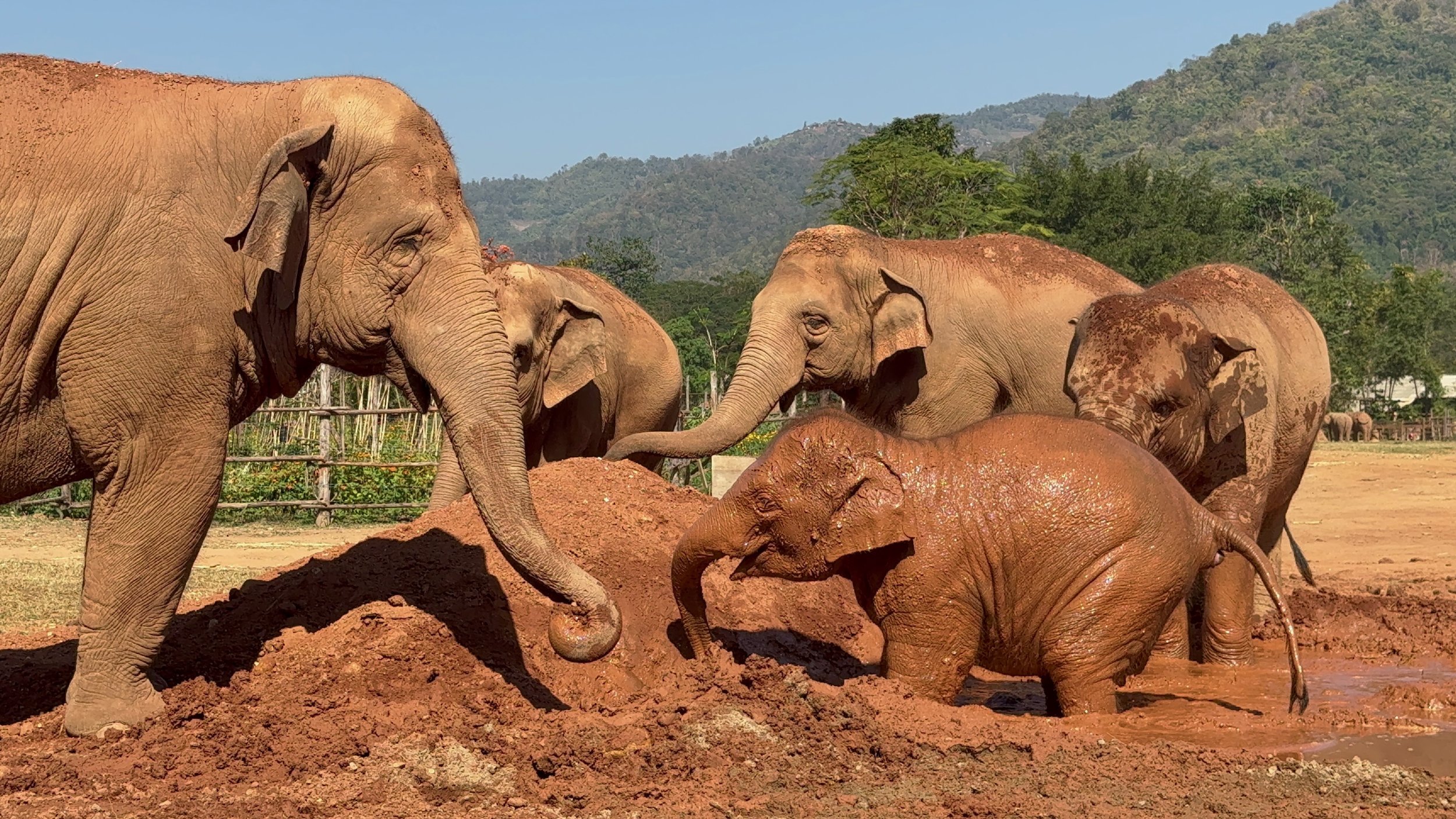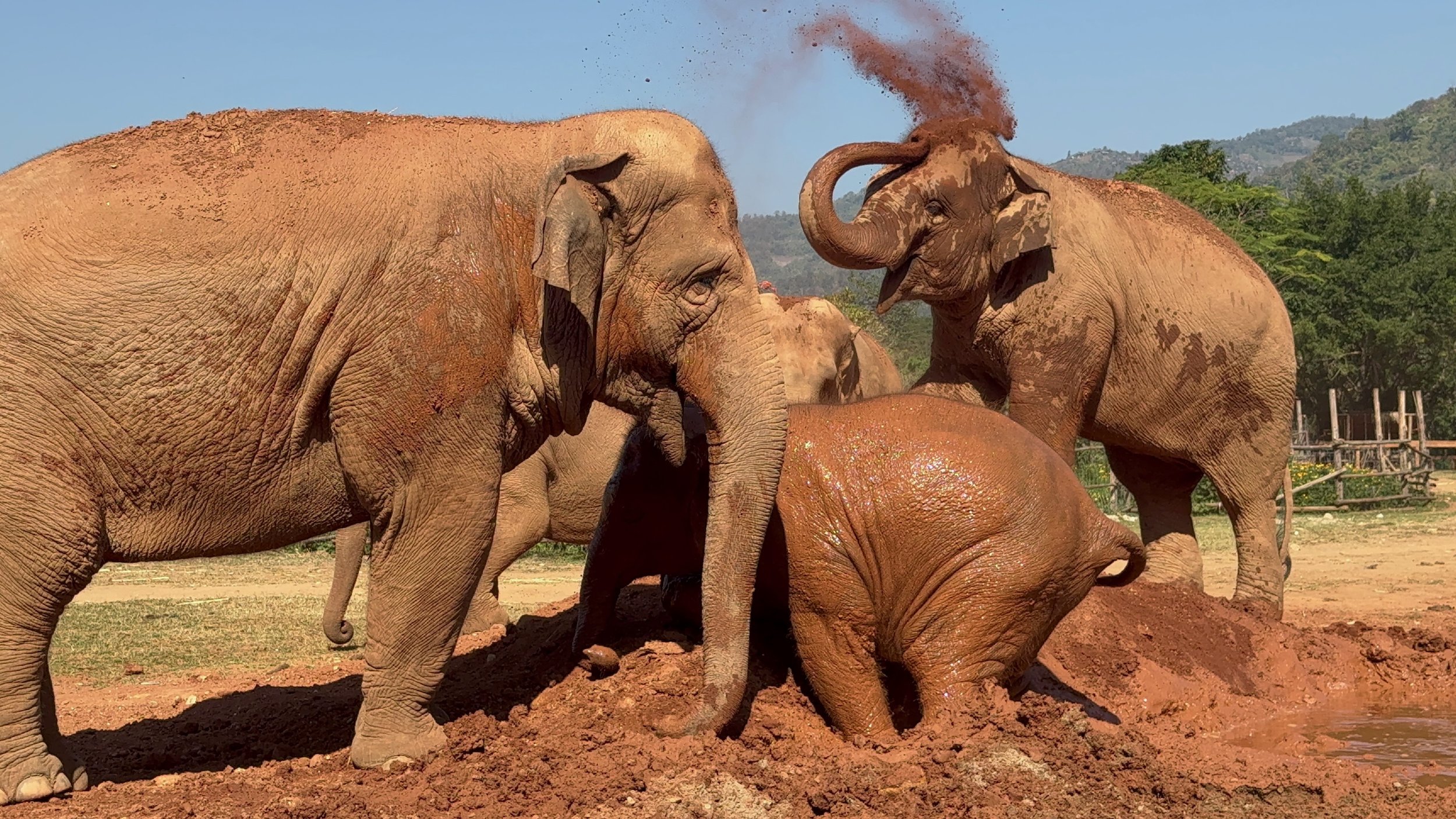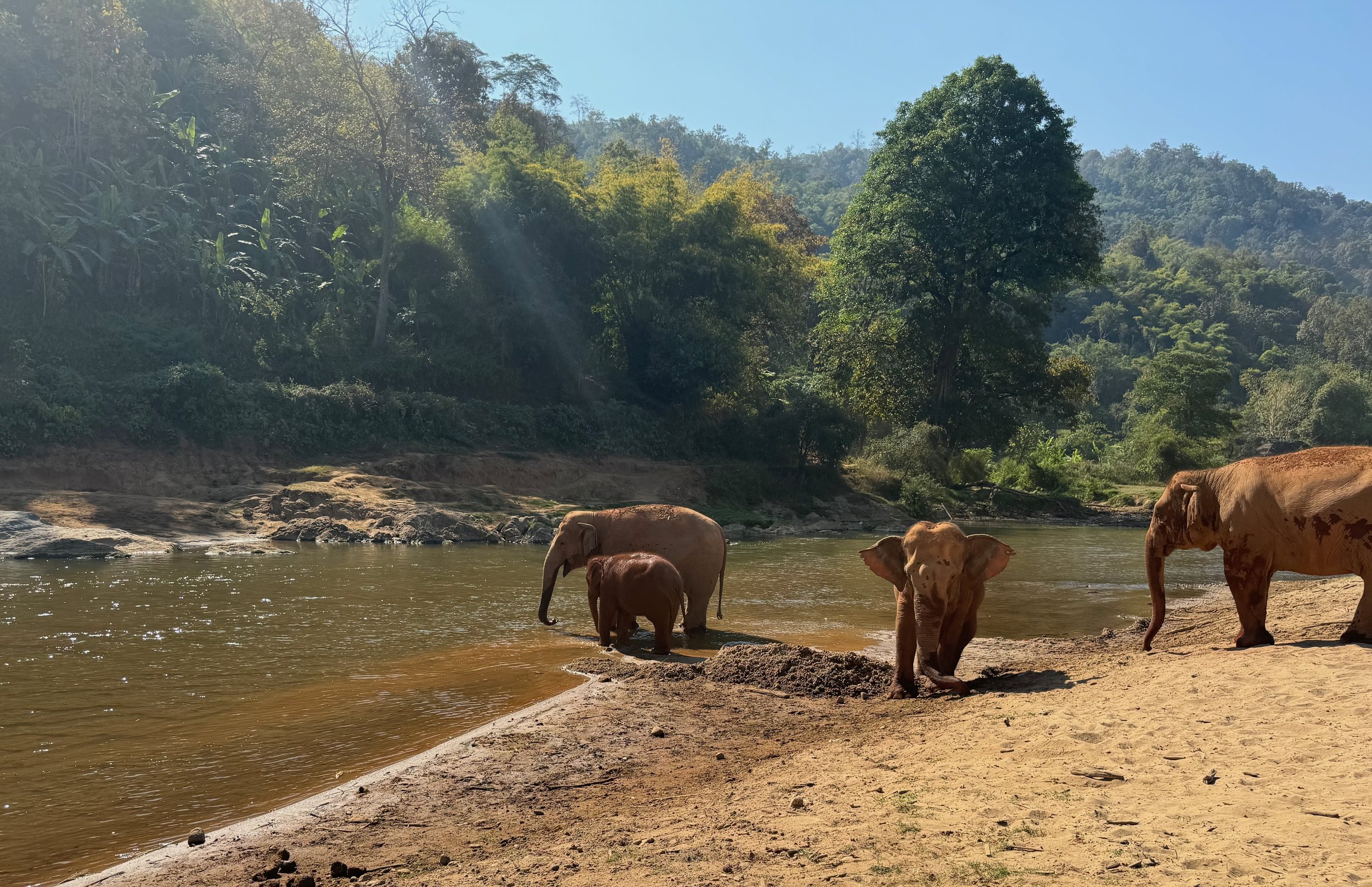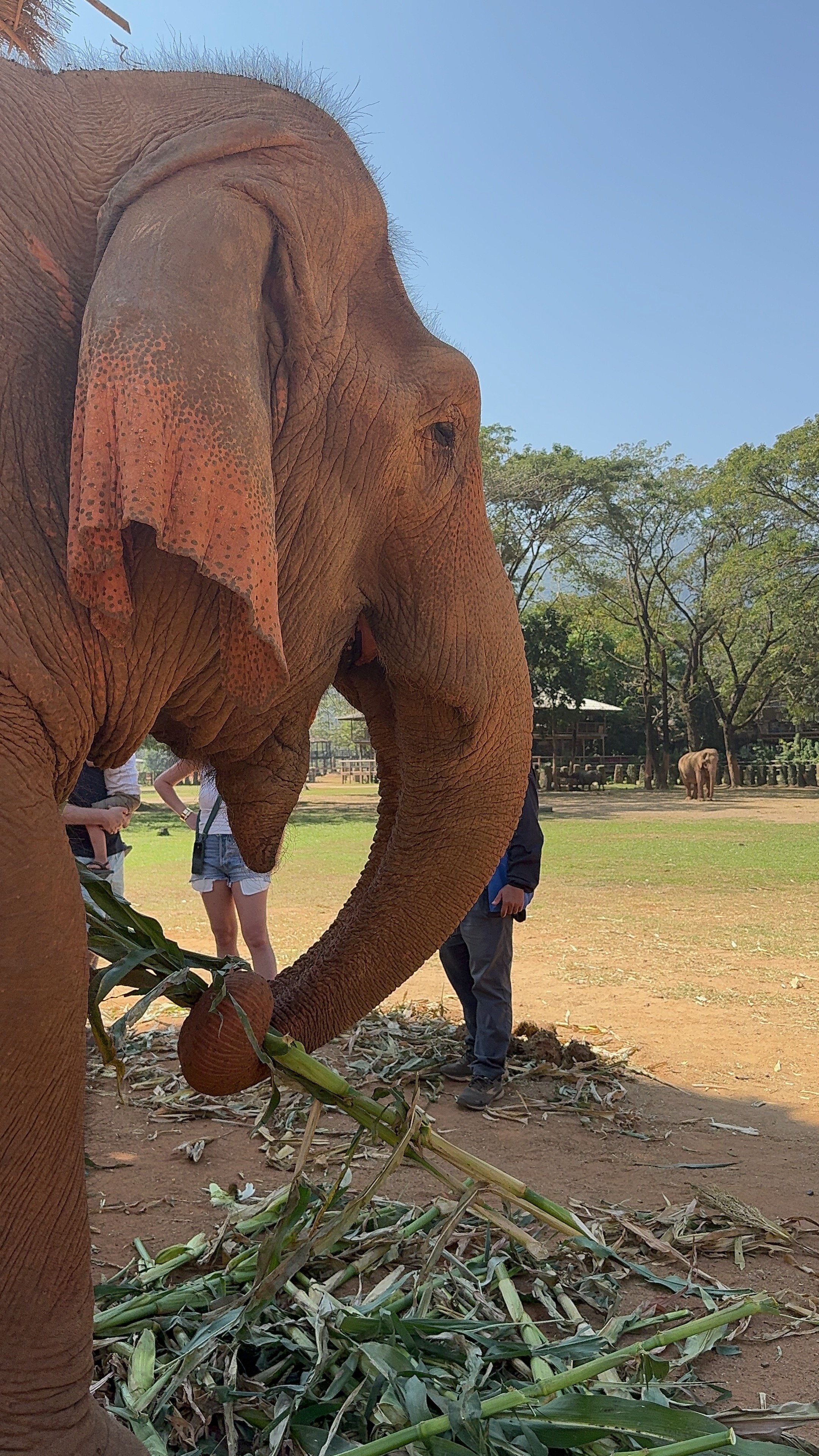Elephant Encounters and Tips for Finding Ethical Places to Visit
Spending time with elephants was a bucket list activity for us. When I began searching for tour companies, I came across an option to ride an elephant in the jungle. Another place allowed tourists to get in the river with them and bathe and feed them. While those activities sound like fun, they are abusive activities for the elephants. Sure we saw glowing, five-star reviews, but if the animals weighed in with their opinions, it might be a different story.
We ended up choosing to spend our time at Elephant Nature Park outside of Chiang Mai, Thailand after a ton of research. Finding a balance of enjoying time with the elephants, and other animals that are rescued and rehabilitated here, while keeping the experience as ethical as possible was critical to us. Our experience is below, and later in this article we share tips for picking the places that treat elephants with as much dignity and respect as possible.
Tourists have tremendous power to continue moving the industry towards ethical entertainment that respects the welfare and dignity of elephants.
Our half-day with the elephants
It was one of the coolest experiences of our travels to be up close and personal with so many majestic elephants during our half day at Elephant Nature Park. The park has a no-touching policy because it can be stressful to the animals, but if it allowed touching, we’d have been close enough to pet more than a dozen or more elephants with no bars or fences separating us. Our visit began at 9am, and we chose that time because we’d be there for feeding time. But if you’re not a morning person, there are half-day afternoon tours and even overnight tours. If you’ve got the time, they also accept volunteers. Whatever you decide, it’s important to book well in advance if you want a specific time.
As we pulled up to Elephant Nature Park, we came upon wooden structures with palm leaves for roofs, netting, some low rustic wood fencing that you’d expect to see on a farm, and scattered thick wooden posts coming out of the ground with woven palm leaf umbrellas cooling off a small cluster of elephants. My sense of anticipation grew as each element came into view, and I felt a little rush of excitement for what more was still to come.
Grazing area as seen from the indoor patio
I’m not sure what I was expecting, but even the indoor part was exhilarating. Details about each individual elephant, conservation information, and so many things to learn offered us a wealth of knowledge. There was more thatched roofing, abundant flowers, and jaw-dropping views of the park and elephants. Of course we wanted to be outside to get closer, but even the prospect of sitting at a table savoring coffee while watching these amazing creatures interact would have been a happy day for us.
Before we approached any of the elephants, our guide took us through a large outdoor area where food was being prepared. Workers were hustling to gather stacks of bananas onto a rug on the cement floor, plastic baskets of fruit were gathered and separated by type, and everyone operated with efficiency to prepare for the snack each elephant would receive. We learned that each elephant ate 50 kilos of fruit and vegetables each day to enhance their diet of grass, bamboo, aquatic plants and more. There were some long tables where kitchen workers were assembling cakes made out of fortified rice meal, fruits and more vegetables. Beginning during COVID when tourism was shut down and funds to support the park were low, an organization had a great idea to raise much-needed funding for some of the food the elephants require. They designed a program where people could celebrate their birthday or other special event by donating the funds for a cake to be made in their honor. The donor could have a say in choosing which elephants could receive the cakes and park staff would preserve the experience with a photo and video of the elephants enjoying the cake that then would be posted to social media and help raise additional awareness. What a clever idea! We know many people who never need anything that would love to be honored in this way.
Gentle Giants Elephants created a way to help you celebrate your special event while also supporting elephant parks
Lucky enjoying tossing dirt onto her back
The primary mission of Elephant Nature Park is to rescue and rehabilitate Asian elephants. Most of them were previously abused, are elderly, handicapped, or orphaned from all over Thailand. They come from backgrounds of logging, as props used for begging on streets, performing in circuses, or working in the tourism industry.
Meeting Lucky
First we met Lucky, an older blind elephant. Elephant Nature Park has a donor website that lists every elephant by herd and their story so you can make a donation in support of a particular animal. I can’t find any information specifically about Lucky there, so it’s possible that’s a nickname our guide uses for her. We were in awe of how close we were able to get as we learned a little about her and mostly watched her throw dirt on her back, which is called “dust bathing.” I had no idea that elephants’ skin is so sensitive, but apparently dirt and mud protect their skin similar to using sunscreen. This was early in the morning and there was a slight chill in the air, so our guide mentioned that the dirt also will help her stay warm. Later in the day when it’s hot, it will have a cooling effect when the moisture in the mud or dirt evaporates under the sun. It’s a barrier against insects and their diseases, is an exfoliant, and also allows them to mark their territory. Beyond these practical uses, dust bathing has a calming, stress-relieving effect on them.
Polly munching on her supplemental food
First Feeding
Next, we met Polly, who is 60 years old. Her ear has been damaged by being mistreated through training from being in a circus. Although elephants typically spend about 60 percent of their time foraging for food, the park provides supplemental nutrition in order to ensure they get a similar variety or quantity of food as they would in the wild. Providing food also is a way for the workers to build trust with the elephants. Foraging for food is important for the elephants for many reasons. It’s an instinctual behavior that also keeps the elephants occupied. It’s good for their mental health because searching for and making food selections helps prevent boredom and encourages problem-solving and decision-making skills. Walking, reaching, and pulling all are good physical activities and also prevent obesity.
Mud baths
Three adult elephants and a baby playing in the mud transfixed us. The guide was in no hurry to move us along, so we watched this adorable interaction for a while. The baby kept rolling in the mud, climbing up on this little mound of dirt, and then laying down again and splashing around. Some elephants are more maternal and nurturing, some are loners, some build relationships in herds that aren’t where they originated. None of the adults in this foursome were the mother of this baby, but they all seem to be having a blast engaging with her.
Three elephants having fun with a baby elephant in the mud
Cleanup time
Time to get a drink after all that rough housing in the mud
All their playing made them thirsty or perhaps they wanted to cool down a bit with some river water. Whatever the reason, the foursome rambled down to the river together and spent some time in the water. It was such fun watching this group interact, and our guide mentioned that these specific elephants tended to naturally spend a lot of time together. Although workers were on hand on the fringes of activities, the elephants made all their own decisions on where to go and what to do. It makes sense that bath time should not involve tourists. While it might seem harmless and fun for us to feel like we are participating in their care, in actuality we would be depriving the elephants of time enjoying each other. Once again, bath time is a stress reliever, a time for bonding with other elephants, and a continuation of their playtime.
Lucky recipients of a special event “cake”
It’s someone’s special day
We made our way to this area barely in time to see a few select elephants enjoying the last bits of a celebration cake, probably one of the cakes that the workers had finished making when we first arrived. The park ensures that there’s a reasonable balance among the elephants so that no one gets left out if they’re not specifically chosen to get a cake. I was surprised that elephants moved away from the food even though some of it remained. Cucumber might be good for elephants, but that doesn’t mean it’s their absolute favorite food, or else these elephants were a little less interested in it this time. Some of the remains may have been harder to pick up with their trunk or else they were pleasantly satisfied and full.
Male elephants are kept separate
Where are the male elephants?
As we made our way slowly back to the main building, we learned about the male elephants residing here, who are deep in the minority compared to females. Females are rescued more frequently for a number of reasons. Females are more easily exploited because their spirits are easier to break and they can be trained more easily. People engaged in the circus and other types of performing and riding industries, logging, and tourism are more likely to capture females. Unfortunately, the process of breaking the animal—called phajaan in some cultures—is particularly cruel. This process often involves physical restraints, starvation, sleep deprivation, and beatings. Since elephants have remarkable memories, they don’t forget that treatment. Males are much more aggressive, so 90 percent of them remain wild and are never broken. Although the majority of them escape abuse, they still may need rescuing if they’ve become orphaned or injured due to natural disasters, poaching, or accidents. Male elephants also may be rescued if they are deemed a threat to human lives or property. The challenge the parks face is that because they are heavier and stronger, it takes more money to rescue them. They’re also less predictable because they’re not broken and are more dangerous to their rescuers. A male elephant can cost between $2-3 million to be rescued, so there’s always a consideration of where the limited funds can do the most good and be stretched the furthest. That often means that females and babies are a bigger priority.
Males tend to be loners, so having them be more isolated from the other elephants doesn’t typically go against their nature. They’re penned separately because they tend to fight if they’re in groups.
A muddy elephant in its full majesty
Lunch is served
Our day wrapped up with a vegetarian buffet that was included in the price of our half-day tour. Afterwards everyone was allowed to stroll on the skywalk, which allowed guests to have an overhead view of the elephants in certain areas. It sounded like it would be a great experience to wrap up our time, but we ended up chatting with a family of five who was traveling around Southeast Asia for a month. Although the teenagers had homework assignments, they said it was well worth the time to have some of the amazing adventures they’d been enjoying as a family, and the Elephant Nature Park was one of the top tours on their list. We hopped on a bus and in less than 45 minutes, we were back at our Airbnb.
Afterwards, I took some time to reflect on why elephants are so intriguing. Of course their magnificent size, their floppy ears, swishy tails, and unique looking trunk makes them eye-catching, but I did a deep dive to find a few more insights about them.
Why elephants are special
Just like humans, eating food is a social activity for elephants
It’s no wonder elephants are captivating. In addition to their immense size, here are some cool fun facts you might not know about them:
They are superb smellers. Their trunks contain 2,000 genes dedicated to smell and allow them to detect water sources up to 12 miles away.
Elephants communicate through trumpets and calls, including ones that are at frequencies too low for humans to hear. They also use vibrations through the ground with the sensitive skin on their feet across long distances to warn each other of danger or guiding them to water sources.
Their thick skin is surprisingly sensitive and susceptible to sunburn. They throw sand, mud, or dust on their backs to act as a natural sunscreen.
Elephants are well known for having a good memory. They can remember distant water holes, recognize the calls of hundreds of other elephants, and even remember elephants they haven't seen for years. They even remember deceased loved ones as evidenced by their communal rituals around death, standing guard over the bodies of the deceased and returning to the bones for years afterward.
They have complex social structures, which are often led by the oldest and largest female elephant. Elephants exhibit behaviors that suggest deep feelings of joy, anger, love, compassion, and grief.
Male elephants tend to roam independently or form smaller, more loosely associated groups separate from females.
They are highly intelligent, they demonstrate the ability to use tools, solve problems, and communicate in sophisticated ways. They exhibit a range of emotions, from joy and love to grief and compassion, showing empathy for their kin and other species.
Ethical Interaction Guidelines
There are so many activities that sounded fun when I started looking for a tour involving elephants. It was only after I looked more deeply that I learned how much is wrong with most of these ideas, so I compiled a list of list of what to avoid and why.
Another blind but magnificent elephant
AVOID Scheduling a jungle tour for riding an elephant (or any activity involving riding)
Here’s why: Despite their size, elephants don’t have strong backs for carrying weight of any type. It’s natural for elephants to want to use their trunks to pour dirt on their backs. They don’t tolerate saddles very easily, so the training process to make them compliant with riding is incredibly harsh and stressful. Elephants are wild animals, and no matter how well they are trained, they can be unpredictable. It’s an exploitative practice as well; the demand for elephant rides directly fuels the capture, domestication, and mistreatment of more elephants.
AVOID Bathing elephants and patronizing places that allow it
Here’s why: Although it might seem like a fun and harmless activity for tourists, there are many reasons to avoid places that allow tourists to bathe elephants. The primary reason is that elephants like to be dirty. They like to dump dirt on their backs and take mud baths. These things are enjoyable to them. And even though elephants’ skin is thick, it’s sensitive and can become easily damaged or irritated. Tourists may inadvertently handle them to roughly or improperly. The water source being used can become polluted and the ecosystem imbalanced due to soaps or other chemicals. Shared water sources also are a breeding ground for disease that potentially can be transmitted between elephants and humans.
AVOID Participating in circuses or any type of performances or shows involving elephants
Here’s why: Training elephants to perform involve brutal, abusive treatments that are fear based and can result in physical injuries, psychological trauma and long-term suffering. Elephants are highly intelligent, social animals and have long memories. They will remember those abuses for the rest of their lives, even if the harsh treatments end. They are confined to unnatural living conditions that are confusing and go against their instincts. Foraging, dust bathing, and social interactions contribute to their mental wellbeing, and if they are deprived of these opportunities, they can develop obsessive compulsive actions, repetitive behaviors, and nervous tiks. Traveling between locations in cramped conditions is physically and emotionally painful for them.
AVOID Engaging in Direct Baby Elephant Interaction or supporting facilities that allow this
Here’s why: Places that allow any sort of feeding, bathing, or playing with baby elephants creates an unnatural and stressful environment for baby elephants. These interactions can be stressful for the young elephants and may interrupt their necessary bonding and learning with their family.
AVOID Buying “elite” elephant dung coffee
Here’s why: In order to produce elephant dung coffee, elephants must eat and digest coffee cherries, which are not a natural part of an elephant’s diet in the wild. Coffee cherries are not a typical or essential food source for them. Eating coffee cherries can could hurt their digestion, may cause stress, discomfort, or health issues. It’s also an exploitive practice and using elephants as mere commodities to produce a luxury product is unethical.
Final thoughts
While interacting with elephants in a responsible and ethical manner can be educational and rewarding, it's essential to prioritize the well-being and natural behavior of the animals. Alternatives to interactive activities like bathing, such as observing elephants from a respectful distance or participating in enrichment and feeding activities under the guidance of experienced caretakers, can provide meaningful experiences for visitors while ensuring the elephants' welfare and conservation remain the top priority.
Additional resources
Zoos are not appropriate places for elephants. They deserve to be free. Here’s a website that ranks the ten worst zoos with the hope of getting them to change their practices and find alternative homes for captive elephants.
Organizations and certifications to look for:
Global Federation of Animal Sanctuaries (GFAS): Accreditation by GFAS indicates a high standard of care.
World Animal Protection: This organization sometimes lists or endorses venues adhering to strict animal welfare standards.
Pacific Asia Travel Association (PATA): They have initiatives focusing on responsible tourism, including animal welfare.
Notable ethical elephant sanctuaries and tours:
We encourage you to do your own research as well beforehand to ensure that their ethical standards have not changed. This list isn’t meant to be completely inclusive.
Asia
Elephant Nature Park, Chiang Mai, Thailand: A pioneering sanctuary known for rescue and rehabilitation efforts, offering observation and limited interaction under strictly controlled conditions to ensure the animals are not stressed.
Boon Lott’s Elephant Sanctuary (BLES), Sukhothai, Thailand: Focuses on providing a safe and natural environment for elephants, allowing them to roam freely with minimal human interaction.
Wildlife SOS Elephant Conservation and Care Center, Mathura, India: Rescues abused captive elephants and provides them with a safe haven, focusing on medical care and rehabilitation.
Elephant Valley Project, Sen Monorom, Cambodia: Offers an eco-tourism experience where visitors can observe elephants in their natural habitat from a respectful distance.
Africa
David Sheldrick Wildlife Trust, Nairobi, Kenya: Renowned for its orphan elephant rescue and rehabilitation program. Visitors can watch the baby elephants being fed and playing in the mud.
Reteti Elephant Sanctuary, Namunyak Wildlife Conservancy, Kenya: Community-owned sanctuary focusing on the rescue, rehabilitation, and release of orphaned and abandoned elephant calves.
Addo Elephant National Park, South Africa: This national park offers a natural habitat for elephants and other wildlife, with guided tours emphasizing conservation and education.
How to avoid supporting abusive practices
Educate Yourself and Others: Learn about the plight of captive and wild elephants and share this knowledge.
Support Ethical Parks and Sanctuaries: Visit and support elephant sanctuaries and organizations that prioritize elephant welfare, conservation, and rehabilitation without exploitative practices.
Advocate for Change: Support legislation and movements aimed at protecting elephants, both in the wild and in captivity.
Responsible Tourism: Choose wildlife experiences and tours that respect animal welfare and promote conservation over entertainment.
By prioritizing ethical interactions with elephants, we can help shift the industry toward more humane and sustainable practices and ensure that these magnificent creatures are respected and protected.


















